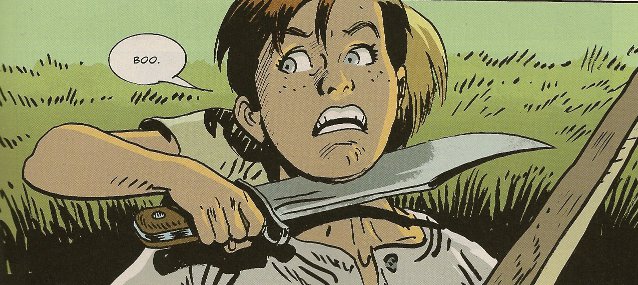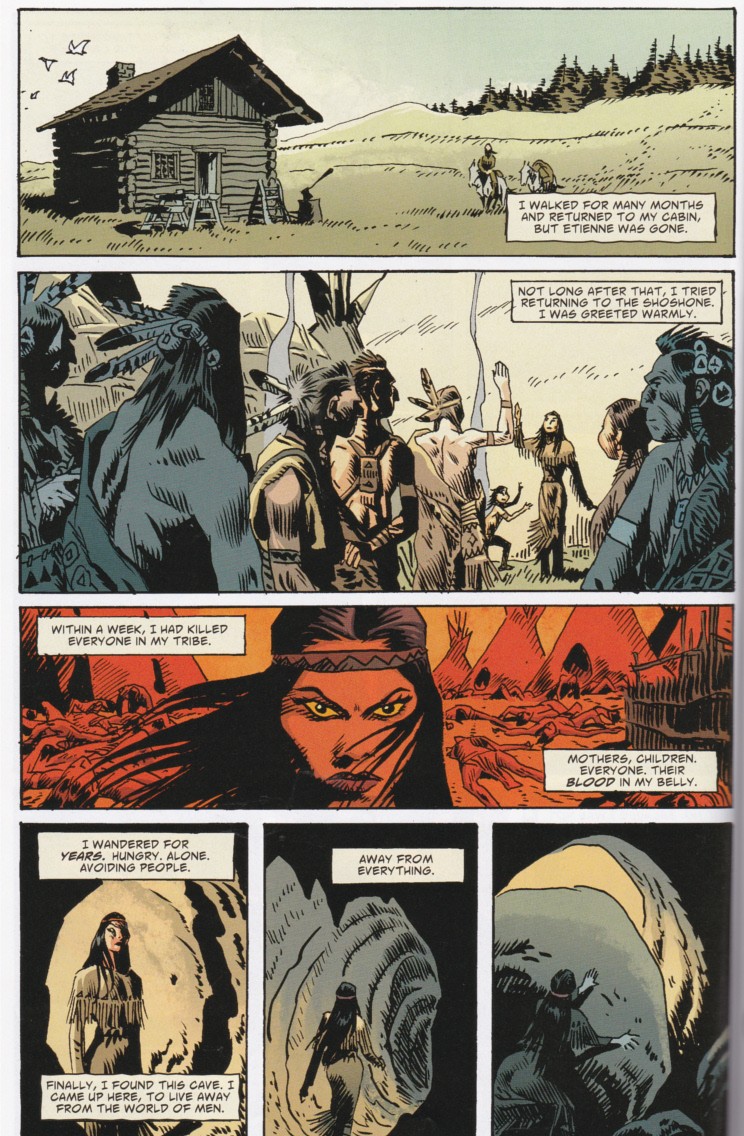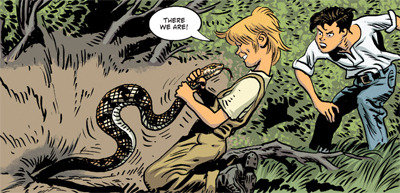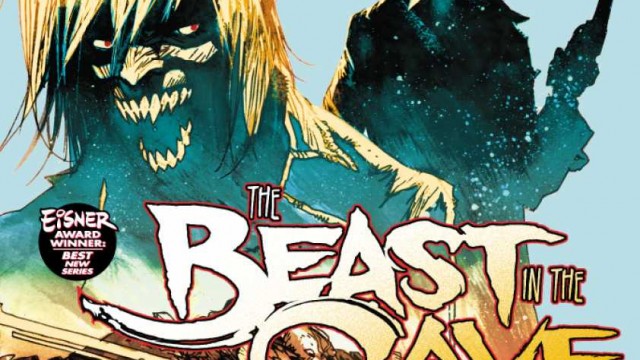The Conversation on the Solute
Avathoir and wallflower discuss American Vampire
Installment 6: The Unforgiven
Warning: American Vampire Conversation has Spoilers. Proceed at your discretion.
Avathoir: Well now, we’ve stumbled into something very interesting here, haven’t we? After finishing up World War II, we’ve suddenly circled back around to a time before even Volume 1 started, before Skinner became a vampire, even. “The Beast in the Cave” is for me the most divisive arc in the entire cycle. It gives us information that we clarifies things, but may not necessarily need clarifying, the art style is entirely unlike any of the ones that come before (not even Sean Murphy was this big a break) and it sets up something that doesn’t get hinted at until the end of the cycle, if that.
And yet…there’s something about it that’s really compelling. It haunts me, gets under my skin. I’m not quite sure why. Wallflower, what was your reaction to this arc?
wallflower: This might be a divisive one for us too, because this one didn’t land for me. However, let’s get some things out of the way first: this isn’t a bad story. It has a haunted feeling to it, of things that can never be fully explained or understood, of things that you try and understand at your own great peril. It has the same kind of mythic impact of the other arcs. It’s not something that’s out of place here.
What it doesn’t feel like is necessary. I’m always suspicious when storytellers go back before the beginning and try and write a pre-origin story. The Stephen King-authored story of Skinner and Jim back in volume one was so effective, and so connected to the mythic version of America, that to make them childhood buddies and then fellow soldiers seems to cheapen that. It makes the story psychological rather than archetypal; they can be more believable in a modern sense, but also less universal. As a reader, you can always escape psychology by saying “well, I’m not that person,” and you’d be right; but the mythic figures are always with us.
I found myself wondering if this story would work better if it wasn’t Skinner and Jim, and possibly so. The story of Mimiteh, the true first American vampire, does have a strong mythic charge to it, and plays one more variation on the classic fable of Be Careful What You Wish For. It also plays into some earlier aspects of American history, mainly the scientific aspects of the westward expansion. Probably my favorite aspect of this entire arc is Mimiteh’s story in the second issue; there’s some really good characterization in her face and her words here. (Sadly, I can’t say the same later in the story; naked, Jordi Bernet gives her the very standard comic-book female look, and nothing throws you out of a story quite as much as wondering where an American Indian gets those kind of 36E implants.) On its own, this has the feeling of a parallel story to the main mythology, and it works on that level.

Avathoir: Never underestimate the average comics artist’s tendency for cheesecake. Jordi Bernett may have lent a “Mark Twain Gone Horribly Wrong” to this story that works like gangbusters (especially in Mimiteh’s origin), but that doesn’t mean we have to excuse his digressions. And that doesn’t mean that just because Snyder has written a good story doesn’t mean we should excuse that in this current context, it’s unnecessary. I have a theory that this is much more important than it initially seems, but after “Ghost War” and “Survival of the Fittest” this is a story that feels like a comparative letdown. Skinner and Jim, adopted brothers? Why, that’s TOTALLY original and not at all an obvious route. Of COURSE they first realized their fundamental differences in the army! Why, it all makes sense now!
Whew, that sarcasm exhausted me. Which is why I think it’s better to talk about the thing that Snyder gets right in a big way: Mimiteh. When you think about it, SHE’S the first American Vampire, not Skinner, and she’s even more inhuman than she is. Her recounting of how she just let herself be carried through history is legitimately unnerving, as her lack of agency is directly tied to her lack of concern, until she makes the decisive choice to become a vampire. The result, the Jesus Christ What The Fuck Is That A Bat Lizard Monster Oh God Oh God Save Me Please is less a reflection of her background (Skinner, a boy of the old west, took on properties like a rattlesnake) than a reflection of her inhumanity. Snyder titled this story “The Beast in the Cave” after a Lovecraft work, and it fits: Mimiteh IS a beast, in both her skills and her being.
wallflower: Go back far enough, and you will find something truly unknowable: that’s what the Mimiteh story feels like. Her earlier interactions with the trapper who she lives with first as servant, then as wife, and then with the explorers Norrell and Clark, have a good, unsettling feeling to them, conveyed through Mimiteh’s monologue and some good work on her facial expressions. And the Lovecraftian appearance of Mimiteh-as-monster gives the same sense as “Survival of the Fittest,” of not just an alternate history but an alternate biology. It’s something Joss Whedon played with as well on Buffy, with one particular character who didn’t become a vampire, but ascended into a true demon. (Just in case our readers don’t know who it is, I’ll keep that one a secret, because it’s just great.)
The framing story just doesn’t feel up to what’s revealed in this story, though. To bring it all back to the idea that Skinner was always like this–in the last panel, we see Jim narrating the idea that there was always something in Skinner “waiting to be set free”–seems to trivialize him. It’s not as bad as what Thomas Harris did with his Lecter origin story in Hannibal Rising (probably the definitive example of an author taking a giant shit over his own creation), but it misunderstands the distinction between mythic and novelistic. The great myths hold that there are some things that cannot be explained; they can only be witnessed. Snyder has been too good at building up the myth of Skinner Sweet for this kind of story to work.

Avathoir: Unlike Harris, I don’t think Snyder was trying to shit on Skinner (for one thing, it’s clear he likes writing, unlike Harris), but I do agree and feel a bit betrayed at the learning of LIttle Teen Sociopath Skinner. I mean, maybe we’ll go back even further and find out about exactly what happened to Skinner’s family (we’ve heard Jim in volume 1 say Skinner’s mother was a prostitute, and yet here we’ve seen that he apparently came from a farming family. I don’t know if Snyder made a continuity error (DREAD CONTINUITY) or if this is going to be Skinner will reveal a Dark and Tragic Past but it does get more at the idea that we’re missing out on something important, and the idea that Skinner was always this way isn’t something that seems right. Skinner is a mythic figure, but he’s not mythical. If that makes any sense.
So let’s think about how this arc will show up in the future. I mean, Mimiteh is still in the cave, and I doubt Snyder is just going to do a one and done type thing, especially for something so controversial. Where do you see this going?

wallflower: Hm. There are multiple ways you can go on this. Mimiteh isn’t enough of a character for me to look at her that way (another weakness she has compared to Pearl, Henry, Skinner, and the rest) so I have to ask what would be some interesting symbolism–unless we go into the past and get into the origin of the really beastial vampires. I could imagine a story where the mountain gets strip-mined and she gets released, or a reverse of that, where some 1960s kids hear about her legend and try and set her free, with funny/satirical results. (My first thought would be something like Eli Roth’s The Green Inferno, but my second and better thought would be the South Park episode set in the rainforest.) Either way, she’s best suited for a story about raising forces you’re not equipped to deal with.
Avathoir: That concludes this arc of American Vampire! Tune in soon for Installment 7: Drive, where we hit the 1950s, and then Installment 8: The Bird of Hermes!

